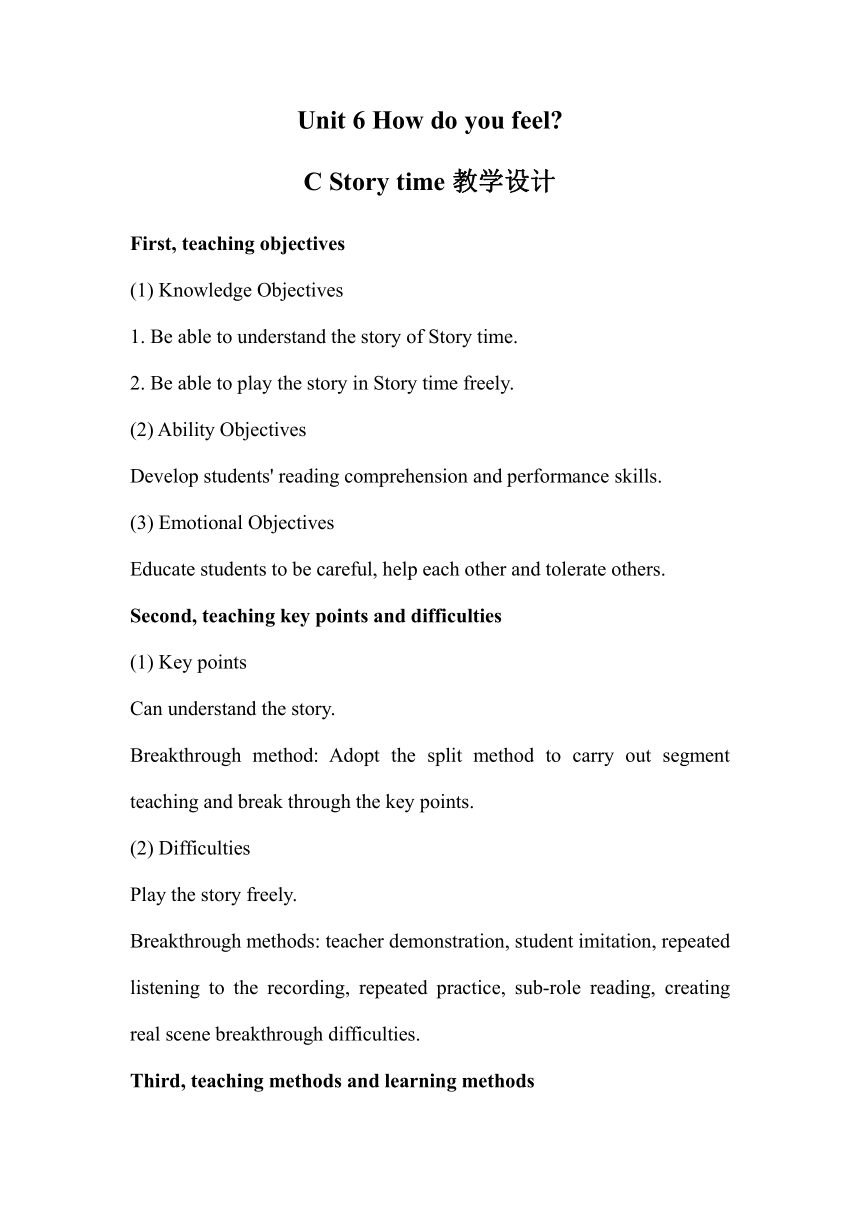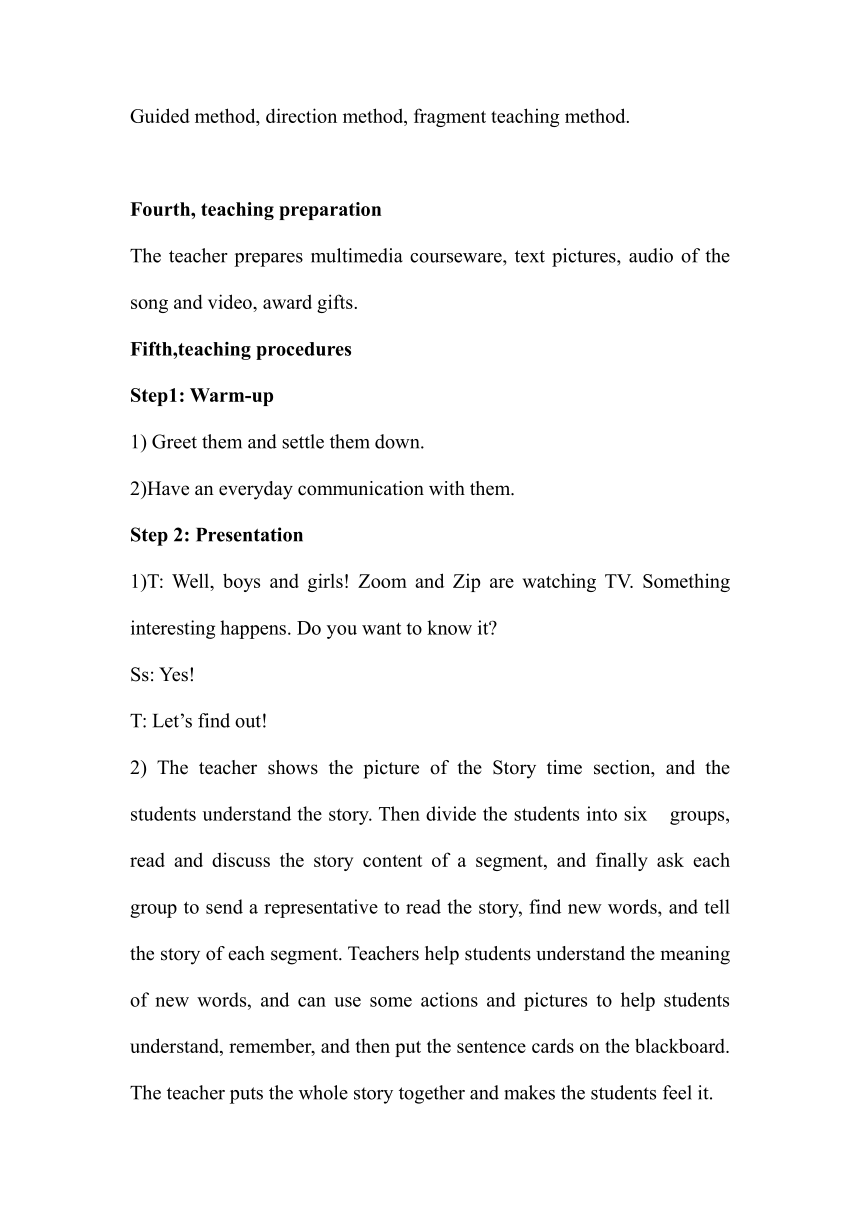Unit 6 How do you feel?C Story time 教案
文档属性
| 名称 | Unit 6 How do you feel?C Story time 教案 |  | |
| 格式 | zip | ||
| 文件大小 | 16.0KB | ||
| 资源类型 | 教案 | ||
| 版本资源 | 人教版(PEP) | ||
| 科目 | 英语 | ||
| 更新时间 | 2021-10-06 09:23:20 | ||
图片预览


文档简介
Unit
6
How
do
you
feel
C
Story
time教学设计
First,
teaching
objectives
(1)
Knowledge
Objectives
1.
Be
able
to
understand
the
story
of
Story
time.
2.
Be
able
to
play
the
story
in
Story
time
freely.
(2)
Ability
Objectives
Develop
students'
reading
comprehension
and
performance
skills.
(3)
Emotional
Objectives
Educate
students
to
be
careful,
help
each
other
and
tolerate
others.
Second,
teaching
key
points
and
difficulties
(1)
Key
points
Can
understand
the
story.
Breakthrough
method:
Adopt
the
split
method
to
carry
out
segment
teaching
and
break
through
the
key
points.
(2)
Difficulties
Play
the
story
freely.
Breakthrough
methods:
teacher
demonstration,
student
imitation,
repeated
listening
to
the
recording,
repeated
practice,
sub-role
reading,
creating
real
scene
breakthrough
difficulties.
Third,
teaching
methods
and
learning
methods
Guided
method,
direction
method,
fragment
teaching
method.
Fourth,
teaching
preparation
The
teacher
prepares
multimedia
courseware,
text
pictures,
audio
of
the
song
and
video,
award
gifts.
Fifth,teaching
procedures
Step1:
Warm-up
1)
Greet
them
and
settle
them
down.
2)Have
an
everyday
communication
with
them.
Step
2:
Presentation
1)T:
Well,
boys
and
girls!
Zoom
and
Zip
are
watching
TV.
Something
interesting
happens.
Do
you
want
to
know
it
Ss:
Yes!
T:
Let’s
find
out!
2)
The
teacher
shows
the
picture
of
the
Story
time
section,
and
the
students
understand
the
story.
Then
divide
the
students
into
six
groups,
read
and
discuss
the
story
content
of
a
segment,
and
finally
ask
each
group
to
send
a
representative
to
read
the
story,
find
new
words,
and
tell
the
story
of
each
segment.
Teachers
help
students
understand
the
meaning
of
new
words,
and
can
use
some
actions
and
pictures
to
help
students
understand,
remember,
and
then
put
the
sentence
cards
on
the
blackboard.
The
teacher
puts
the
whole
story
together
and
makes
the
students
feel
it.
Step
3:
Practice
The
teacher
plays
the
recording
of
the
Story
time
part,
and
the
students
repeatedly
reads,
imitate
the
voice
intonation
and
feel
the
story
situation.
Ask
a
student
with
a
good
English
foundation
and
a
teacher
to
demonstrate
the
story.
Then
the
group
and
the
group
are
divided
into
roles
to
read
the
text.
Finally,
the
members
in
the
group
are
equipped
with
free
movement
exercises,
and
only
some
of
the
fragments
can
be
practiced,
and
several
groups
of
students
are
invited
to
perform.Award
for
The
Best
Performer.
2)The
teacher
scrambles
the
six
pictures
in
the
story,
and
then
the
teacher
reads
the
sentences,
ask
active
students
to
put
the
cards
on
the
blackboard
in
the
correct
order.
Then
the
ss
will
read
the
story
together.
Step
4:
Consolidation
and
homework
1.
Try
to
retell
the
story
to
your
parents
or
friends.
2.
Do
the
supporting
exercises
on
the
activity
manual.
Sixth,blackboard
design
Unit
6
How
do
you
feel
C
Story
time
My
favourite
TV
show
is
on
soon.
Do
you
have
any
popcorn
I’ll
go
and
make
some.
I’ll
go
and
check.
I
planted
the
popcorn
seeds.
They
take
a
long
time
to
grow.
Seventh,
teaching
reflection
In
the
course
of
the
lesson,
the
two
lessons
have
reviewed
the
key
knowledge
of
the
unit
and
improved
the
students'
story
understanding
ability.
In
the
process
of
story
teaching,
the
teacher
uses
the
method
of
segment
teaching
and
team
discussion,
which
disperses
the
key
points
of
the
class
well
and
concentrates
the
students'
attention.
Primary
school
students
are
more
active
and
imaginative.
Group
discussions
can
effectively
help
students
to
participate
in
the
classroom.
In
active
discussion,
middle
school
students
can
also
shine
wisdom
and
stimulate
students'
imagination
and
creativity.
However,
the
primary
school
students'
self-control
ability
is
poor,
and
the
teachers'
ability
to
master
the
overall
classroom
is
better.
It
is
not
allowed
for
students
to
discuss
freely
and
discuss
without
purpose.
It
is
very
important
for
students
to
have
clear
discussion
content
and
discussion
objectives.
The
report
after
discussion
is
A
feedback
on
the
effectiveness
of
the
discussion
process,
teachers
should
continue
to
accumulate
experience
from
such
feedback,
thereby
improving
classroom
discussion
efficiency.
6
How
do
you
feel
C
Story
time教学设计
First,
teaching
objectives
(1)
Knowledge
Objectives
1.
Be
able
to
understand
the
story
of
Story
time.
2.
Be
able
to
play
the
story
in
Story
time
freely.
(2)
Ability
Objectives
Develop
students'
reading
comprehension
and
performance
skills.
(3)
Emotional
Objectives
Educate
students
to
be
careful,
help
each
other
and
tolerate
others.
Second,
teaching
key
points
and
difficulties
(1)
Key
points
Can
understand
the
story.
Breakthrough
method:
Adopt
the
split
method
to
carry
out
segment
teaching
and
break
through
the
key
points.
(2)
Difficulties
Play
the
story
freely.
Breakthrough
methods:
teacher
demonstration,
student
imitation,
repeated
listening
to
the
recording,
repeated
practice,
sub-role
reading,
creating
real
scene
breakthrough
difficulties.
Third,
teaching
methods
and
learning
methods
Guided
method,
direction
method,
fragment
teaching
method.
Fourth,
teaching
preparation
The
teacher
prepares
multimedia
courseware,
text
pictures,
audio
of
the
song
and
video,
award
gifts.
Fifth,teaching
procedures
Step1:
Warm-up
1)
Greet
them
and
settle
them
down.
2)Have
an
everyday
communication
with
them.
Step
2:
Presentation
1)T:
Well,
boys
and
girls!
Zoom
and
Zip
are
watching
TV.
Something
interesting
happens.
Do
you
want
to
know
it
Ss:
Yes!
T:
Let’s
find
out!
2)
The
teacher
shows
the
picture
of
the
Story
time
section,
and
the
students
understand
the
story.
Then
divide
the
students
into
six
groups,
read
and
discuss
the
story
content
of
a
segment,
and
finally
ask
each
group
to
send
a
representative
to
read
the
story,
find
new
words,
and
tell
the
story
of
each
segment.
Teachers
help
students
understand
the
meaning
of
new
words,
and
can
use
some
actions
and
pictures
to
help
students
understand,
remember,
and
then
put
the
sentence
cards
on
the
blackboard.
The
teacher
puts
the
whole
story
together
and
makes
the
students
feel
it.
Step
3:
Practice
The
teacher
plays
the
recording
of
the
Story
time
part,
and
the
students
repeatedly
reads,
imitate
the
voice
intonation
and
feel
the
story
situation.
Ask
a
student
with
a
good
English
foundation
and
a
teacher
to
demonstrate
the
story.
Then
the
group
and
the
group
are
divided
into
roles
to
read
the
text.
Finally,
the
members
in
the
group
are
equipped
with
free
movement
exercises,
and
only
some
of
the
fragments
can
be
practiced,
and
several
groups
of
students
are
invited
to
perform.Award
for
The
Best
Performer.
2)The
teacher
scrambles
the
six
pictures
in
the
story,
and
then
the
teacher
reads
the
sentences,
ask
active
students
to
put
the
cards
on
the
blackboard
in
the
correct
order.
Then
the
ss
will
read
the
story
together.
Step
4:
Consolidation
and
homework
1.
Try
to
retell
the
story
to
your
parents
or
friends.
2.
Do
the
supporting
exercises
on
the
activity
manual.
Sixth,blackboard
design
Unit
6
How
do
you
feel
C
Story
time
My
favourite
TV
show
is
on
soon.
Do
you
have
any
popcorn
I’ll
go
and
make
some.
I’ll
go
and
check.
I
planted
the
popcorn
seeds.
They
take
a
long
time
to
grow.
Seventh,
teaching
reflection
In
the
course
of
the
lesson,
the
two
lessons
have
reviewed
the
key
knowledge
of
the
unit
and
improved
the
students'
story
understanding
ability.
In
the
process
of
story
teaching,
the
teacher
uses
the
method
of
segment
teaching
and
team
discussion,
which
disperses
the
key
points
of
the
class
well
and
concentrates
the
students'
attention.
Primary
school
students
are
more
active
and
imaginative.
Group
discussions
can
effectively
help
students
to
participate
in
the
classroom.
In
active
discussion,
middle
school
students
can
also
shine
wisdom
and
stimulate
students'
imagination
and
creativity.
However,
the
primary
school
students'
self-control
ability
is
poor,
and
the
teachers'
ability
to
master
the
overall
classroom
is
better.
It
is
not
allowed
for
students
to
discuss
freely
and
discuss
without
purpose.
It
is
very
important
for
students
to
have
clear
discussion
content
and
discussion
objectives.
The
report
after
discussion
is
A
feedback
on
the
effectiveness
of
the
discussion
process,
teachers
should
continue
to
accumulate
experience
from
such
feedback,
thereby
improving
classroom
discussion
efficiency.
同课章节目录
